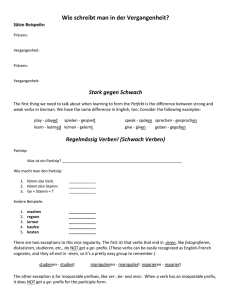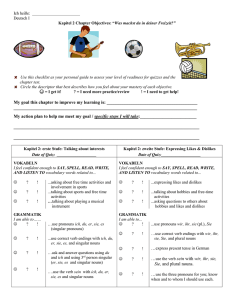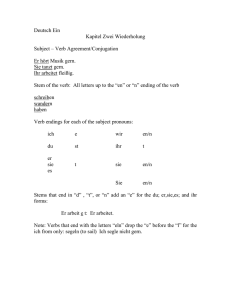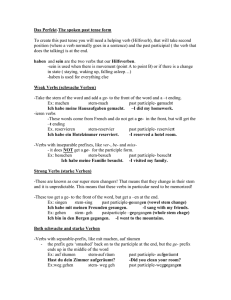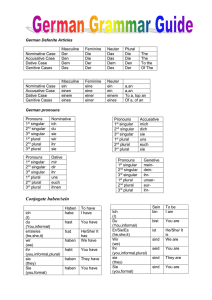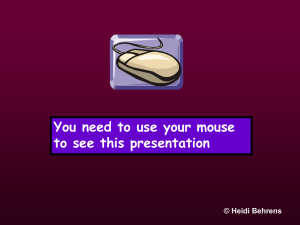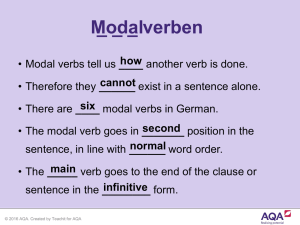Copyright © 2004 by Robert A. Morrey NomAkkErkl2 D1A50204
Werbung
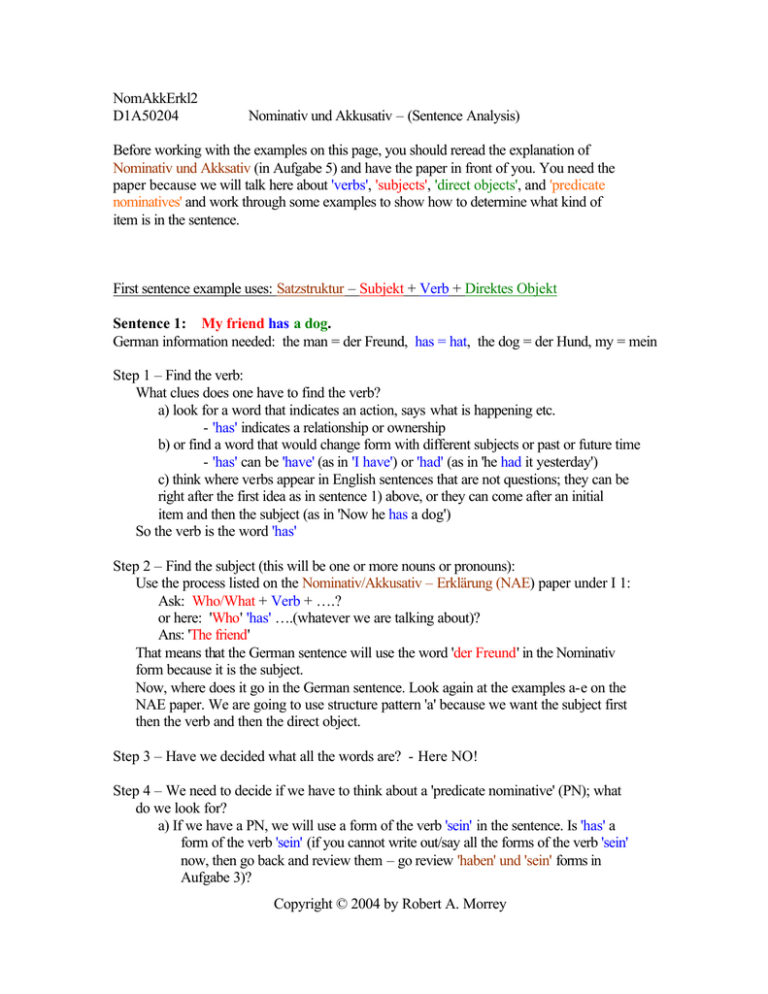
NomAkkErkl2 D1A50204 Nominativ und Akkusativ – (Sentence Analysis) Before working with the examples on this page, you should reread the explanation of Nominativ und Akksativ (in Aufgabe 5) and have the paper in front of you. You need the paper because we will talk here about 'verbs', 'subjects', 'direct objects', and 'predicate nominatives' and work through some examples to show how to determine what kind of item is in the sentence. First sentence example uses: Satzstruktur – Subjekt + Verb + Direktes Objekt Sentence 1: My friend has a dog. German information needed: the man = der Freund, has = hat, the dog = der Hund, my = mein Step 1 – Find the verb: What clues does one have to find the verb? a) look for a word that indicates an action, says what is happening etc. - 'has' indicates a relationship or ownership b) or find a word that would change form with different subjects or past or future time - 'has' can be 'have' (as in 'I have') or 'had' (as in 'he had it yesterday') c) think where verbs appear in English sentences that are not questions; they can be right after the first idea as in sentence 1) above, or they can come after an initial item and then the subject (as in 'Now he has a dog') So the verb is the word 'has' Step 2 – Find the subject (this will be one or more nouns or pronouns): Use the process listed on the Nominativ/Akkusativ – Erklärung (NAE) paper under I 1: Ask: Who/What + Verb + ….? or here: 'Who' 'has' ….(whatever we are talking about)? Ans: 'The friend' That means that the German sentence will use the word 'der Freund' in the Nominativ form because it is the subject. Now, where does it go in the German sentence. Look again at the examples a-e on the NAE paper. We are going to use structure pattern 'a' because we want the subject first then the verb and then the direct object. Step 3 – Have we decided what all the words are? - Here NO! Step 4 – We need to decide if we have to think about a 'predicate nominative' (PN); what do we look for? a) If we have a PN, we will use a form of the verb 'sein' in the sentence. Is 'has' a form of the verb 'sein' (if you cannot write out/say all the forms of the verb 'sein' now, then go back and review them – go review 'haben' und 'sein' forms in Aufgabe 3)? Copyright © 2004 by Robert A. Morrey b) No. 'Has' is a form of the verb 'to have' or 'haben', so we do not have a predicate nominative Step 5 – Now check if there is a direct object Use the process on the NAE paper under II. Ask: Whom/What + do/does + subject + main verb? [Note if your main verb is a form for 'he' that usually ends in 's' (as in 'he has'), then that verb will change form here in this question to the form for 'they', because the 's' sound is now on the word 'does'] We ask here: What does the friend have? Ans: 'the dog' – and this word is the direct object by definition because it is the answer to the question. You may only use 'who/whom' or 'what' to find the direct object; you cannot use other question words like 'when', 'why', 'how', 'where', etc. That means that the German sentence will use the accusative case for 'the dog' because direct objects must use accusative case forms by definition. Step 6 – We know the 'verb' is 'has', the 'subject' is 'the friend' and will be in the nominative case, and the 'direct object' is 'the dog' and will be in the accusative case. To create a good sentence you must also know whether the words you are using in German are masculine, feminine, or neutral, because the definite article 'the' and the indefinite article 'a' have different endings depending on the gender of the noun. You must also know the word order needed for the sentence or question type you wish to use (see Satzstruktur in Aufgabe 4); we will use the pattern 'Subjekt' + 'Verb' + Direktes Objekt' for our sentence. Step 7 – End result: Subjekt/Nom. Der Freund Verb (agrees w. subject in number) hat Direktes Objekt (Akk.) einen Hund. Copyright © 2004 by Robert A. Morrey Second sentence example uses: Satzstruktur – Verb + Subjekt + Direktes Objekt + …? [Do you remember what happens with 'do/does' and 'is/are'? If things are a little unclear about where the 'does' goes, look back at the 'do/does/is/are' paper in Aufgabe 3] Sentence 2: Does the man see the movie? German information needed: the man = der Mann, see = sehen (ie), the movie = der Film For the steps below, follow the same procedure that was outlined for the first sentence above: Step 1 – Find the verb: Ans: 'does' is a helping verb, but is not used in German when there is another verb in the sentence. 'see' is a word that indicates an action and is the main verb. Step 2 – Find the subject (the subject will always be one or more nouns or pronouns): We ask: who does see/ who is seeing …(something)? Ans: 'the man', so 'the man' is the subject and will be used in the nominative form Step 3 – Have we decided what all the words are? - Here NO! Step 4 – We need to decide if we have to think about a 'predicate nominative' (PN)? We see if the verb is a form of the verb 'sein'. It is not, so no PN Step 5 – Now check if there is a direct object We ask: What does the man see? Ans: 'the movie', so 'the movie' is the direct object and will be used in the accusative form. [Note! Since this is a question, we do not know if he sees it or not, but he either does see the movie or he does not see the movie; in either case, what he sees or does not see is the movie so it is still the direct object whether he sees it or not, because we are talking about 'the movie'.] Step 6 – We know the 'verb' is 'see', the subject is 'the man', and the direct object is 'the movie'. Step 7 – End result: Verb + Subjekt Sieht der Mann + Direktes Objekt? den Film? Copyright © 2004 by Robert A. Morrey The next sentence examples use: Satzstruktur – Subjekt + Verb + (Direktes Objekt/PN) Sentence 3: The boy is my brother. German information needed: the boy = der Junge, is = ist (form of 'sein'), the brother = der Bruder, my = mein For the steps below, follow the same procedure that was outlined for the first sentence above: Step 1 – Find the verb: Ans: 'is' – you should recognize is as a form of the verb 'sein' (if you cannot write out/say all the forms of the verb 'sein' now, then go back and review them – go review 'haben' und 'sein' forms in Aufgabe 3) Step 2 – Find the subject: We ask: who is …(something)? Ans: 'the boy, so 'the boy' is the subject and will be used in the nominative form Step 3 – Have we decided what all the words are? - Here NO! We now will be able to do either step 4 or step 5 whichever fits the situation. Step 4 – We need to decide if we have to think about a 'predicate nominative' (PN)? We see if the verb is a form of the verb 'sein'. It is! Now we need to look at the NAE sheet under I 2. 2. and see if there are two words in the sentence that equal the same person. Ans: 'the boy' and 'my brother' both refer to one person. That means the we have a PN. So the word 'my brother' is the predicate nominative, because we already determined that 'the boy' is the subject. No more items to determine, so we stop. [Note! The same word cannot be both a predicate nominative and a direct object.] Step 5 – Now check if there is a direct object – if you continue, it does not work. We ask: What does the boy is?/ Who does the boy is? Ans: the questions make no sense, so there is no direct . Step 6 – We know the 'verb' is 'be', the subject is 'the boy', and the predicate nominative is 'my brother'. Step 7 – End result: Subjekt Der Junge + Verb ist + PN mein Bruder. Copyright © 2004 by Robert A. Morrey Sentence 4: Who is your brother? German information needed: who = wer, 'is' = ist (a form of 'sein'), the brother = der Bruder, your = dein (or 'euer' or 'Ihr') Note! The word 'who' is at the same time a question word and either a subject or an object. Sometimes it helps to replace 'who' in the sentence with the proper name of a person such as 'Anna' or 'Peter'. Then analyze the sentence and put 'who' back in at the end – I will use Peter. Step 1: Verb is 'is', a form of the verb 'sein' [so we immeidately think we might have a PN in this sentence, because that can only happen when we do have the verb 'sein'] Step 2: Find the subject: We ask: Who is … (somewhere, someone, something)? Ans: Peter (so 'Peter' is the subject and in the nominative case) Step 3: Still more words. Step 4: Do we have a PN? Ans: Yes. We have a form of the verb 'sein' and we have the words 'Peter' and 'your brother' that refer to only one person (Note that 'your' tells us something about 'brother' but we are comparing 'Peter' with 'brother' not with 'your') That means that both the subject and the PN will be in the nominative case. Step 5: Does not apply. Step 6: We know that the verb is 'is', the subject is 'Peter/who', the predicate nominative is 'your brother' Step 7: End result: Wer ist dein Bruder? Copyright © 2004 by Robert A. Morrey Sentence 5: Yes. My sister is going to school today. German needed: my = mein, the sister = die Schwester, is = (not used), going = (form of) gehen, today = heute, to (the) school = zu der Schule/zur Schule Step 1: Verb is 'go' Step 2: Who goes/is going …? Ans: my sister That means that 'my sister' is in the nominative case and 'my' has to have a feminine ending in the nominative case. Step 3: There are still more words. Step 4: Do we have a PN. No. The verb 'is' is not the only verb in the sentence, so it is therefore not used in German and so there can be no PN. Step 5: Do we have a direct object? Ask: What does my sister go? [Note! You can only use 'what' or 'who/whom' to find the direct object. If your question makes no sense –as it does here – then you have no direct object] Step 6: We know that the verb is 'gehen', the subject is 'my sister'. We also know that the other two items are neither a predicate nominative nor a direct object. [Point of information: 'today' is an adverb of time, 'to school' is a prepositional phrase – look up 'What is a preposition?' in the book English Grammar …] Step 7: End result Meine Schwester geht heute zur Schule. Sentence 6: The boy works hard/a lot. German needed: the boy = der Junge, to work = arbeiten, hard/a lot = viel Step 1: Verb = 'arbeiten' Step 2: Subject Ask: Who works …? Ans: 'the boy' = subject and nominative case Step 3: More words? Yes. Step 4: No PN (verb is not 'sein') Step 5: Direct object Ask: What does the boy work? [You could ask 'How does the boy work?', but that is not a question that determines a direct object. This question is nonsense so there is no direct object] Step 6: Verb is 'arbeiten', subject is 'the boy'. [The word 'hard' is an adverb describing how the boy works and is neither a predicate nominative nor a direct object.] Step 7 - End result: Der Junge arbeitet viel. Copyright © 2004 by Robert A. Morrey
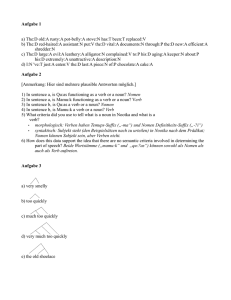
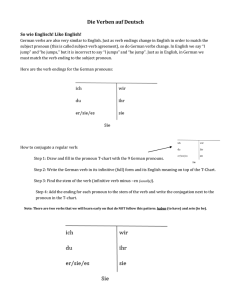
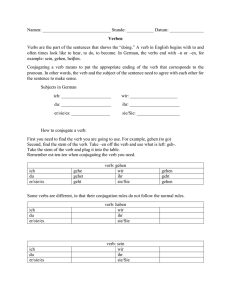
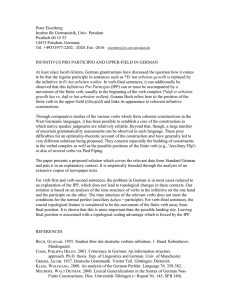
![D1A5 Starke Verben [Strong Verbs]](http://s1.studylibde.com/store/data/005537802_1-7c1b99dd5766654382e175dbf31adcce-300x300.png)
